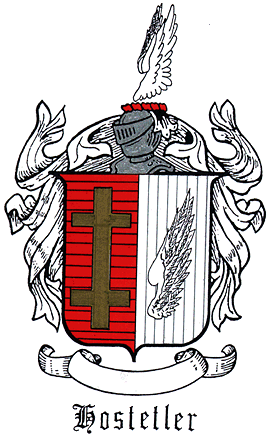Coat of Arms
Until about 1100 A.D. most people in Europe were called by only one name. As populations grew, it became increasingly ridiculous and awkward to refer to a quarter or a third of the population as Daniel or Richard, so they began to add a second name to differentiate and identify who they were.
There were four main sources for these second names, coming from: the bearer's occupation, the bearer's town or place of origin, the parent's name, some particular characteristic of the person.
One occupational group found it necessary to go a step further: the Fighting Man. The fighting man of the middle ages wore a metal suit of armor for protection. Since this suit of armor included a helmet that completely covered the head, a knight in full battle dress was unrecognizable. To prevent friend from attacking friend during the heat of battle, it became necessary to somehow identify himself. Many knights accomplished this by painting colorful designs on their battle shields. These designs were also woven into cloth surcoats which were worn over a suit of armor. Thus was born the term, "Coat of Arms".
As this practice grew more popular, it became more and more likely that two knights, unknown to each other, might be using the same insignia. To prevent this, records were kept that granted the right to a particular design to a particular knight. His family also shared his right to display these arms. Four of the most famous registries on heraldry are: Armorial General by J.B. Rietstap, Grosses Wappenbuch by Johann Siebmacher, General-Index Zu Den Siebmacher'schen Wappenbuchern by Hanns Jager-Sunstenau and Neues Historisches Wappenbuch Der Stadt Zurich by Jean Egli. These volumes are available at most metropolitan public libraries.
Over time, as civilization took deeper root and fighting by the sword diminished, the practice of granting "Coats of Arms" continued, but the Swiss began granting them to important urban dwellers rather than landowning nobility. Thus a member of our Hochstetler ancestry who held an important post such as magistrate or councilor or who was a member of a board of directors of a craft or trade guild could very likely have been granted a coat of arms.
This is in marked contrast with other European countries that granted coats of arms, particularly in the early years of the tradition, to those who rendered protection of valuable services to a king or emperor. Many times they were also granted estates for the successes they achieved on the battlefield as opposed to the Swiss tradition of honoring successes in commerce and community.
The Swiss were very proud of their distinctive heraldic tradition of rewarding outstanding members of the community with a "Coat of Arms". It's this egalitarian attitude and this respect for all the men and women that have contributed to the success of modern Switzerland that is celebrated today by all Swiss including the proud bearers of our family name.
The following four "Coats of Arms" were granted, by Swiss authority, to members of our ancestry and rendered by an Italian Heraldic Artist from information officially recorded in ancient heraldic archives:





